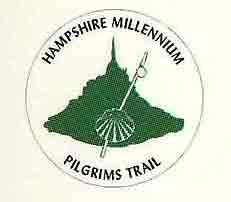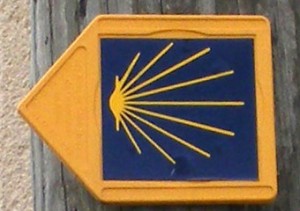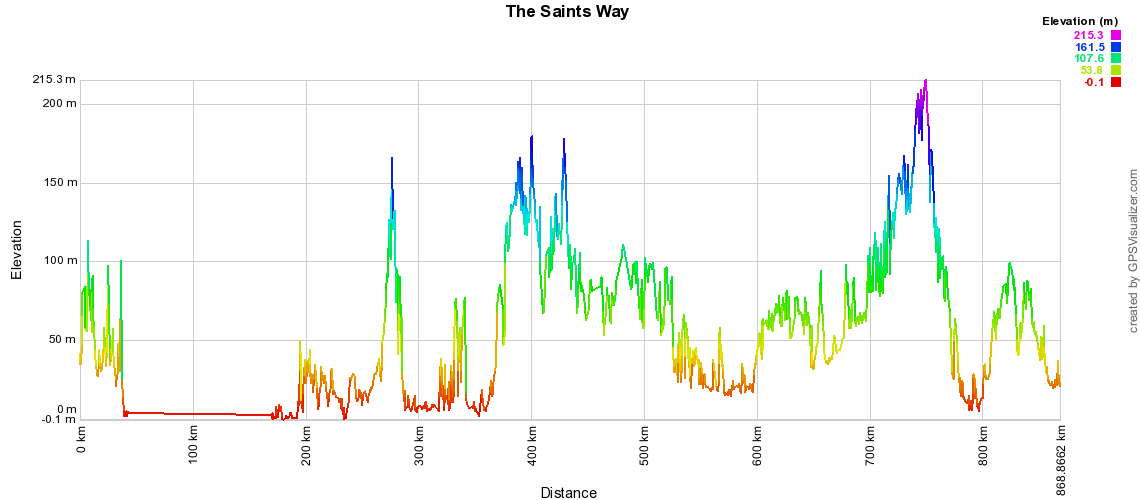The route is an amalgam of the Millenium Pilgrim’s Trail in England and the chemin Anglais and the chemin Plantagenêt in France.
Taken as a whole the route enables pilgrims to travel from Winchester Cathedral to join the chemin de St Jacques (the St James Way/Via Turonensis/El Camino) at St Jean d’Angely in the region of Poitou-Charentes in the west of France.
The trails have historically also been followed by English and French pilgrims travelling to the medieval sanctuary of le Mont Saint Michel in Normandy.
The modern day pilgrim has the choice of a brief exposure to pilgrim travels in the United Kingdom, following the historic route to le Mont Saint Michel or striking out to join the Camino de Santiago de Compostela.
The route is generally well signposted and on good quality tracks over generally level ground. In northern France we have proposed shorter sections for those walkers that are concerned about their fitness. As you progress south and develop your fitness the sections increase in length.
Total distance of the route: 790km
Maximum Altitude: 213m
Typical hiking duration: 28-35 days for the entire route
The Road to the Stars
From the 9th century, pilgrims have followed the route of the sun to the west and at night they replaced this with a stream of stars, the Milky Way. The aim of their journey was to visit the tomb of St. James the Great, one of the twelve apostles of Christ, who tradition believes to be entombed in the cathedral of Santiago de Compostela. Many of those early pilgrims could have made their way from today’s four main starting points of the St James Way in France, but many others would have made their way from their homes taking in other valued pilgrimage sites and then joining El Camino at the most convenient point.
For English pilgrims the Three Saints way is one probable route. The name, Three Saint’s Way, has been created by the authors of the LightFoot Guides and is based on the three saints associated with this pilgrimage: St Swithin, St Michael and St James. Far from being a single route, it is in fact a collection of intersecting routes starting at the shrine to St Within in Winchester Cathedral and comprised of the Millenium Footpath Trail in England and the Chemin Anglais and chemin Plantagenêt in France, which ultimately lead to the Way of St James in St Jean d’Angely – also known in the middle ages for housing the relics of St John the Baptiste.
Winchester Cathedral and Saint Swithin
Saint Swithin, a former teacher of the young Alfred the Great, was famous for charitable gifts and building churches. Only one miracle is attributed to St Swithin while he was alive. An old lady’s eggs had been smashed by workmen building a church. Swithin picked the broken eggs up and, it is said, they miraculously became whole again. St Swithin died on 2 July 862. His grave just outside the west door of the Old Minster, so that people would walk across it and rain fall on it, in accordance with Swithin’s wishes. On 15 July 971, St Swithin’s remains were dug up and moved to a shrine in the cathedral by Bishop Ethelwold. Miraculous cures were associated with the event, and Swithin’s feast day is the date of the removal of his remains, not his death day. However, the removal was also accompanied by ferocious and violent rain storms that lasted 40 days and 40 nights and are said to indicate the saint’s displeasure at being moved. This is probably the origin of the legend that if it rains on Saint Swithin’s feast day, the rain will continue for 40 more days. Saint Swithin is the patron of Winchester Cathedral.
St Michael and le Mount Saint Michel
The archangel, St Michael, is said to have appeared to the Bishop of Avranches, St Aubert, in 708 and instructed him to build a church on a rocky mound in the immense bay – churches dedicated to St Michael are often built on the top of hills or mountains. When the Bishop repeatedly delayed, St Michael apparently burned a hole in the Bishop’s skull with his finger.
A small church was eventually built and consecrated on the 16th October 709. In 966 a community of Benedictines settled on the rock at the request of the Duke of Normandy and a larger church was built and then in the 11th century, the Romanesque abbey church was constructed over a set of crypts at the apex of the rock.
Saint Michael is usually depicted as an angel, standing over a dragon, sometimes piercing it. He is also shown as the angel of judgment, holding scales and balancing the souls of the good and evil.
In 1467 the Order of St Michael was established in France. Members of the Order wore a gold collar with a medallion of St Michael fighting the serpent standing on Mont-Saint-Michel. The gold chain was made of scallop shells, the symbol of pilgrimage in general and to Santiago in particular.
With Rome and Santiago de Compostela, le Mont Saint Michel was one of the most important places of pilgrimage for the medieval west. For nearly one thousand years men, women and children went there by roads called the “Paths to Paradise” hoping to be given the assurance of eternity, by the Archangel of judgement
UNESCO identified le Mont Saint Michel as a world heritage site in 1979. The site now welcomes more than three million visitors a year.
In 199 8 Les Chemins du Mont-Saint-Michel (the St Michael’s Ways) was founded with the objective of locating and promoting the ancient pilgrim routes leading to the sanctuary, including those linking with the United Kingdom, Ireland and Northern Europe.
8 Les Chemins du Mont-Saint-Michel (the St Michael’s Ways) was founded with the objective of locating and promoting the ancient pilgrim routes leading to the sanctuary, including those linking with the United Kingdom, Ireland and Northern Europe.
In 2000  the Hampshire County Council waymarked a trail (the Millennium Pilgrim’s trail) following a Roman Road from Winchester to Bishop’s Waltham and then to Portsmouth to link with the onward route to le Mont Saint Michel.
the Hampshire County Council waymarked a trail (the Millennium Pilgrim’s trail) following a Roman Road from Winchester to Bishop’s Waltham and then to Portsmouth to link with the onward route to le Mont Saint Michel.
in January 2007, the St Michael’s Ways were officially recognised as a Cultural Route of the Council of Europe.
The resurrection of the trails to Santiago de Compostela can be attributed mainly to Don Elias Valina Sampedro a priest and scholar from O Cebreiro who devoted over 30 years of his life to the restoration of El Camino as a pilgrimage trail. In 1967 he wrote his doctoral thesis on ‘The Road of St James: A Historical and Legal Study’.
In 1985 Don Elias was entrusted with the co-ordination of all the resources for the Camino. ‘Refugios’ were established and he was the first to mark the way with yellow arrows, begging for yellow paint from the departments of roads. Also in 1985 UNESCO declared the city of Santiago de Compostela a World Heritage Site.
When travelling south from le M ont Saint Michel walkers will encounter the modern form of the traditional signs for El Camino
ont Saint Michel walkers will encounter the modern form of the traditional signs for El Camino
 The route is also in part shared with the Grand Randonée route GR36 before joining the GR655 – the Way of Saint James/Via Turonesis/El Camino.
The route is also in part shared with the Grand Randonée route GR36 before joining the GR655 – the Way of Saint James/Via Turonesis/El Camino.










